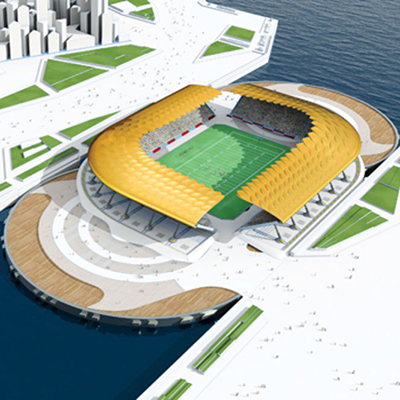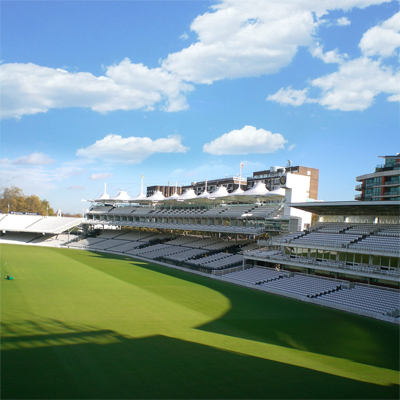Build it and they Will Come: the Rise of the smaRt stadium

The rise of smart stadiums is the answer to the challenges currently facing the industry all over the world. How do you convince audiences to leave the comfort of their home entertainment systems to battle with the masses at stadiums, to fight for a parking spot, to spend time in long queues? Smart stadiums can vastly improve the customer experience and consequently instil longevity in the building.
This challenge of fan engagement and audience retention is spearheading a revolution in stadium design both for new and existing projects. Tech is at the forefront of minds when designing new stadiums. “Our primary competitors weren’t other sports teams in the area or even other events…our primary competitor was the couch” said Sean Kundu, vice president of new ventures for the San Francisco 49ers in the US on conceiving the team’s new venue.1
Let’s take a look at a theoretical smart stadium. The paperless ticket on your smartphone provides you with details on the traffic en route, the food stands at the stadium with the shortest queue. You can order food to your seat, collect loyalty points for merchandise and even learn about any trouble onsite.2
All of these features help to provide a personalised experience to the fans. Delivering a great customer experience is first and foremost in stadium’s objectives. The internet of things technology that smart stadiums consist of can seriously improve the fan experience. A smart stadium deployment integrates numerous systems, including sensors, cameras and digital signs, all of which must connect to wired and wireless networks, as well as servers. The sensors provide up-to-date information on events in and around the stadium.3
IoT capabilities demand investment in infrastructure. The Levi’s stadium that hosted the 2016 Super Bowl had a huge amount of infrastructure to be able to generate this kind of information. 400 miles of cable, 1,3000 access points and over 2,000 location beacons.4 The beacons recognise the location of audience members with the data collected used to help them find their seats, locate concessions and learn the status of their orders.5 “Like Google Maps for buildings” explained Kundu. Technology is being incorporated into plans rather than being an add on, signalling a huge shift in how stadiums are designed.
IoT infrastructure also helps improve operational efficiency. For example triggers to let maintenance workers know when a set number of visitors has been exceeded thus leading to cleaner bathrooms. Another is an optimisation of energy use due to the ability to monitor and change temperatures and lighting throughout a venue via a single dashboard.6
Information gleaned from the IoT era could also help with future planning. “This data-rich environment lets us crowdsource information to generate a feedback loop back into the design process” said Jonathan Mallie, principal and director at global architecture firm Populous.7
To future-proof stadiums, design plans now have an opportunity to build a new vision for both watching and playing sport. “The viewing experience within a stadium environment has not fundamentally changed since Vespasian ordered the construction of the Colosseum almost 2000 years ago” said Christopher Lee, MD EMEA of Populous. “Technology and information technology is literarily changing the playing field.”
Other smart stadium ideas include holographs that hover over the field with the various match and player statistics, combining the TV and in-stadium coverage. Automation can provide drone-delivery of refreshments and electro-magnetic pods that move along with rails allowing fans a view from anywhere.10
The Mercedes-Benz Stadium in Atlanta, Georgia in the US is a shining example of this new age technology. It is the first in the world with a 360-degree halo screen which means no matter where audiences sit, they get a perfect view of replays. The roof is made up of eight triangular panels that close in unison, the aim to create an oculus effect like a camera’s aperture (controling the amount of light admitted through the opening). “Our aim is to deliver technology in a unique way you can’t get at home” explained Bill Johnson, design principal at HOK who designed the stadium echoing the goal of encouraging fans to leave their homes and engage at the stadium.
Delivering technology that is unique to how fans would experience the event at home is perhaps the key underlying message to future-proofing stadium designs. “I can imagine the day where you’re watching a player and his stats appear and float above his head while he’s playing,” says Jeff Marsilio, vice president of global media for the NBA. “Or maybe you choose to augment the experience with comic book ‘pow’ and ‘bam’ effects. You could even give them big heads like in NBA Jam. With this technology, anything’s possible. It’s just a question of what the fans want.”
Sustainability:
Achieving sustainable development is a key objective of the State of Qatar and the SC, so all proposed 2022 FIFA World Cup™ stadiums are being built with a resolute focus on the future.
We are working towards Global Sustainability Assessment System (GSAS) certification for all stadiums. To gain accreditation, and to create venues that the next generation can be proud of, only the most environmentally friendly practices and materials are being used. Renewable and low energy solutions are being incorporated wherever possible, helping stadiums to become energy selfsufficient and even to power other facilities in some cases.
Transportation systems taking fans to stadiums will also assist in the journey towards sustainability. Qatar Rail is currently building metro, rail and light rail systems that will take cars off the road, further reducing the environmental impact of the 2022 FIFA World Cup™ stadiums – and helping Qatar to build a greener future for us all.
Legacy:
The 2022 FIFA World Cup™ will give Qatar and the Middle East a set of worldclass stadiums, magnets for future events of every kind. More importantly, these stadiums will be suitable for Qatar’s domestic football league as well
as other local sporting and cultural events.
Many of the venues will feature modular designs to allow excess seating, approximately 170,000 seats, to be removed post-2022. These seats will be donated to football projects around the globe, helping to spread the love of the game and spurring its worldwide development. The stadiums’ reduced capacities will create arenas of the right size for local football and other sporting events, guaranteeing a vibrant atmosphere.
The areas surrounding Qatar’s FIFA World Cup™ stadiums will become focal points for their communities. The precincts will enjoy high-quality sporting facilities, parks, schools, transport links, shopping centres and places of worship. These amenities will be vital cogs in helping the country to achieve the development goals set in out the Qatar National Vision 2030.
Creating a smart and connected stadium that transforms customer experience will be at the forefront of project updates and new builds. To meet changing consumer trends, stadiums should not see technology as the enemy but make it work for them. To learn more, the World Stadium Congress is definitely the most definitive and important annual meeting place for the stadium industry.
References:
1. https://bleacherreport.com/articles/2707007-hyperconnected-transformer-stadiums-are-the-future-for-football-fans
2. Ibid
3. https://biztechmagazine.com/article/2018/05/how-sports-entertainment-venues-use-IoT-make-stadiums-smarter
4. https://bleacherreport.com/articles/2707007-hyperconnected-transformer-stadiums-are-the-future-for-football-fans
5. https://biztechmagazine.com/article/2018/05/how-sports-entertainment-venues-use-IoT-make-stadiums-smarter
6. Ibid
7. https://bleacherreport.com/articles/2707007-hyperconnected-transformer-stadiums-are-the-future-for-football-fans
8. https://worldfootballsummit.com/smart-football-stadium-populous/
9. Ibid
10. https://bleacherreport.com/articles/2707007-hyperconnected-transformer-stadiums-are-the-future-for-football-fans
|
Read More: Smart Stadiums: Harnessing B2B Technology for Enhanced Operational Efficiency
|





